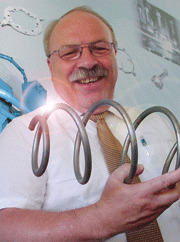E-Archive
MFN Trainer Column
in Vol. 20 - March Issue - Year 2019
Challenge

Albert Schlatter
E-Mobility as a matter of fact is already reality.
However the topic includes a number of open questions which must be solved.
For example:
What will change?
How and how fast can necessary changes be implemented?
Even these few issues can only be finally answered when the question regarding the future energy source to power these changes is solved and implemented.
At present, it’s all about finding the answer to the question whether battery or fuel cell electro mobility, respectively electric- or hydrogen energy, will succeed.
The availability of necessary resources will be a matter of central importance.
In any case, it can be stated that competition to replace combustion engines is in full swing.
Let us hope that technical solutions - both in an ecological and economic respect – will be available sooner than was the case in the development of the Swiss railway system.
Looking back, one can claim that the current railway system in Switzerland with its close meshed net of private and state owned railway facilities including the longest double-track tunnel (57 km) worldwide is a real model of success.
However, there was a rather huge time gap between steam-powered engines in the middle of the 19th century and the first electric railway (Tramway Vevey – Montreux – Chillon, VMC) in 1888.
But let’s get back to the present:
Aluminium production has increased by about 6% in both 2017 and 2018; the automotive industry being the main driving force behind this boom, along with sectors like packaging, aerospace etc.
All forecasts indicate a further growth in aluminium production; however, estimates or assumptions differ greatly.
With the automotive industry in focus, new and lighter weight components will be requested
Besides parts such as battery housings or elements for the car body and structure, future developments will for example, include shock tower supports, steering knuckles etc., all manufactured with lighter unit weights through mass production.
On the grounds of this huge demand, all established players will be competing by proposing different production methods with different materials.
This refers to shaping techniques for aluminium-magnesium alloys, sheet steel parts, steel alloys and also synthetic materials, in addition to aluminium-magnesium alloys produced through
pressure die-cast methods.
Production methods introducing new material or manufacturing technologies are highly conceivable and desirable.
Competition between different materials will lead to interesting solutions.
Seen from today’s point of view, iron foundries will be on the losing side when it comes to the substitution of combustion engines.
Hitherto existing large volumes of cast iron parts – e.g. motor blocks, cylinder heads, crank shafts, piston rods, suspension parts will decline sooner or later.
Under the heading “Challenge” I would like to bang the drum within this column for future cast-iron part production.
Learning from iron foundry specialists and what I have seen, methods for the production of thin-walled and lighter parts are already starting to be developed.
This refers not only to the design of components but also to adequate alloys and suitable moulding, pouring and cooling processes.
It is exactly here where shot-peening procedures will be applied in order to achieve these desired properties in relation to iron castings.
Depending on parts and alloys, a particular and reliable shot-peening procedure can be used to achieve desired improvements.
Close cooperation at an early stage between specialists in research and development departments in both, iron foundries and shot-peening works would be the best approach.
Such a cooperative approach forms the basis that leads to optimum results.
Shot peening offers proven procedures and systems for these new challenges.
However the shot-peening systems in question must be tailored to cope with individual tasks.
This also refers to the blasting medium.
Besides other demands, the following will be of importance in respect to quality of products: Prevention of impact points or deformation
If very precise shot peening is required, air blasting with nozzles must be applied.
This technology is particular suitable for small series.
Air blast-systems, as for example robotic peening systems, which allow the complete processing of parts in one cycle, are equipped with automatic exchange of nozzles without any intervention by the operator.
For cost reasons, shot peening using wheel-blast technology will be applied during mass production.
Here, the following 3 items will be in focus:
First: Position and location of the blast wheel arrangement in order to achieve the best possible angle of impact of the shot on the relevant areas of the workpieces
Second: The abrasive cleaning system should include spiral separators besides the usual pneumatic separator.
Third: Work-piece handling must be controlled so that no impact damage occurs while loading, unloading or during the shot peening process.
Machine Systems could be Manipulator machines and/or Rotary Chamber machines. Both machine types operate in fully automatic mode and are loaded or unloaded by robots. Hanger-type machines could also be an option.
For questions contact: albert@mfn.li
Author: Albert Schlatter



























